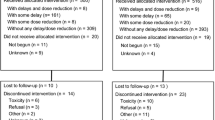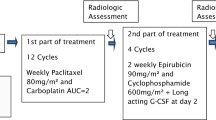Summary
The objective of our clinical studies was to develop an effective combination chemotherapy regimen (CHT) with acceptable side effects, consisting of the two most potent drugs used as single agents in breast cancer. We tested the combination of an anthracycline, epirubicin (A) at 70 mg/m2 i.v. on day 1 or (B) at 120 mg/m2 i.v. on day 1 with an alkylating drug ifosfamide (IFO), (C) at 2.5 g/m2 in an i.v. infusion given over 4 h on days 1–3 or (D) at 5 g/m2 in a 24-h i.v. infusion given on day 1. Courses were repeated every 4 weeks. The combinations were given as first-line therapy as follows: CHT (A, C) in six cases and CHT (B, C) in five cases of advanced breast carcinoma, and CHT (B, D) in seven patients with primary inflammatory breast cancer. Due to side effects (e.g., stomatitis, mental disturbances) and applicability, CHT regimen (B, D) was preferred. Responses (12/18) occurred 1–3 cycles earlier than those previously achieved using the conventional epirubicin/cyclophosphamide CHT. We conclude that 5 g/m2 IFO given i.v. over 24 h with uroprotection (mesna) in a two-drug regimen is an effective dose with tolerable toxicity. Alopecia was seen in all cases. However, according to our experience, myelotoxicity is the dose-limiting factor for both of these drugs.
Similar content being viewed by others
References
Ahmann DL, Bisel HF, Hahn RG (1974) Phase II clinical trial of ifosfamide (NSC-109724) in patients with advanced breast cancer. Cancer Chemother Rep 58:861
Bonadonna G, Brambilla C, Rossi A (1984) Epirubicin in advanced breast cancer. In: Bonadonna G (ed) Masson, Milan. Advances in anthracycline chemotherapy: epirubicin, pp 63–70
Brade WP, Herdrich K, Varini M (1985) Ifosfamide — pharmacology, safety and therapeutic potential. Cancer Treat Rev 12:1
Brambilla C, Delena M, Rossi A, Valagussa P, Bonadonna G (1976) Response and survival in advanced breast cancer after two noncross-resistant combinations. Br Med J 1:801
Brock N, Pohl J, Stekar J (1981) Studies on the urotoxicity of oxazaphosphorine cytostatics and its prevention: II. Comparative study on the uroprotective efficacy of thiols and other sulfur compounds. Eur J Cancer Clin Oncol 17:1155–1163
Brock N, Pohl J, Stekar J (1981) Studies on the urotoxicity of oxazaphosphorine cytostatics and its prevention: III. Profile of action of sodium 2-mercaptoethanesulfonate (mesna). Eur J Cancer Clin Oncol 17:1377–1387
Buzdar AU, Legha SS, Tashima CK, Yap HY, Hortobagyi GN, Hersch EM, Blumenschein GR, Bodey PG (1979) Ifosfamide versus cyclophosphamide in combination drug therapy for metastatic breast cancer. Cancer Treat Rep 63:115
Ganzina F (1983) 4-Epidoxorubicin: a preliminary overview of clinical data. Cancer Treat Rev 10:1–22
Hayward IL, Carbone PP, Heuson IC, Kumaoka S, Segaloff A, Rubens RD (1977) Assessment of response to therapy in advanced breast cancer. Cancer 39:1289
Henderson IC, Hayes DF, Come S, Harries IR, Canellos G (1987) New agents and new medical treatments for advanced breast cancer. Semin Oncol 1:34
Hunter HL, Harrison EF (1982) The anticancer spectrum of ifosfamide. Semin Oncol 4 [Suppl 1]:96
Kaufmann M, Henderson IC, Enghofer E (eds) (1989) Therapeutio management of metastatic breast cancer. W. de Gruyter, Berlin New York
Klein HO, Wickramanayake PD, Coerper CL (1983) High dose ifosfamide and mesna as a continuous infusion over five days — a phase I/II trial. Cancer Treat Rev 10 [Suppl A]:167–173
Salmon SE, Jones SE (1979) Studies of the combination of Adriamycin and cyclophosphamide (alone or with other agents) for the treatment of breast cancer. Oncology 36:40
Scheulen ME, Niederle N, Bremer K (1983) Efficacy of ifosfamide in refractory malignant diseases and uroprotection by mesna: results of a clinical phase II study with 151 patients. Cancer Treat Rev 10 [Suppl A]:93–101
Stuart-Harris RC, Harper PG, Parsons CA (1983) High dose alkylation therapy using ifosfamide infusion with mesna in the treatment of adult advanced soft-tissue sarcoma. Cancer Chemother Pharmacol 11:69–72
WHO (1979) Handbook for reporting results of cancer treatment. Offset Publication 48, WHO, Geneva
Zalupski M, Baker LH (1988) Ifosfamide. J Natl Cancer Inst 80:556
Author information
Authors and Affiliations
Rights and permissions
About this article
Cite this article
Schmid, H., Kaufmann, M., Grischke, EM. et al. Ifosfamide combination chemotherapy in advanced breast cancer. Cancer Chemother. Pharmacol. 26 (Suppl 1), S71–S73 (1990). https://doi.org/10.1007/BF00685426
Issue Date:
DOI: https://doi.org/10.1007/BF00685426




